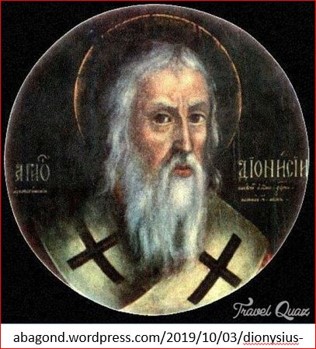
When we hear or read “Easter table” today, we usually think of something like on the photo left. A beautifully set holiday table decorated with eggs, flowers, and bunny figurines.
But we have also inherited another interpretation from ancient times. The old term “Easter table” also has essential religious, scientific, and astronomical meanings.
In this post, we review the history of the Easter tables, which were essential in developing the AD system. We also examine the Easter tables’ supposed role in the assumed “misalignment of the AD time“.
Look at an old Easter table below; it looks like an ancient calendar!

Like its Jewish predecessor, Passover, Easter is a rotating, moving holiday whose date changes from year to year depending on the relationship between the day of the vernal equinox (VEQ) and the date of the full moon.
To simplify, the first day of Easter is the first Sunday after the first full moon following the vernal equinox VEQ.
The Easter table is a timetable that astronomically summarises decades in advance on which day Easter will fall in the future. The Christian Church has proclaimed Easter every year according to the Easter table in force at that time.
Each line of an Easter table corresponds to one year.
The method (algorithm) to calculate the day of Easter (computus paschalis, or computus for short), which is connected to the AD time and so to the current hypothesis, was developed initially by Egyptian Christian priest-astronomers.
The authors and constructors of the Easter tables essential for our topic are the followings:
- St. Cyril of Alexandria (ca. AD376 – AD444)
- Dionysius Exiguus (ca. AD470 – ca. AD544)
- St. Bede the Venerable (ca. AD672 – AD735)
The AD years given above are retroactively calculated years. Earlier, other year-identifications were given without using the AD system that did not yet exist.
Alexandrian Easter tables existed before the Cyrillic period, too. Other Easter tables with slightly different algorithms were also constructed in the above time; however, they did not become significant in our AD time reckoning.
Today we are convinced that Bishop Cyril and the monks Exiguus and Bede were living historical individuals, and their successive, closely linked, “chain-like” Easter tables are genuine and relevant.
The period covered by these Easter tables is usually a multiple of the 19-year Metonic cycle. (see Explanations)
Easter Table of St. Cyril of Alexandria

Cyril continued earlier traditions invented by Anatolius of Alexandria to calculate the Date of Easter.
Ágoston Teres writes in “The Bible and Astronomy “:
“Bishop Cyril began his first cycle with the 153rd year of Diocletian and ended the last with the 247th year of the same tyrant.”
This corresponds to the Easter table period of AD437 – AD531.
The fall of the Western Roman Empire in AD476 happened during this period.
At this ancient time, counting was “inclusive”: between AD437 and AD531 elapsed not 94 but 95 years, as counting included the first and the last year. The inclusive counting (including) is unusual for us, but it is correct; it is only a matter of opinion.
For Bishop Cyril, the idea of a new time reckoning, introducing the serial numbers of the years starting with the year of Jesus’ birth or any other old Christian year, was outside his mind.
The last line of his Easter table was marked Anno Diocletian 247. Surprisingly, this marking was also abbreviated AD. (We use later for this ADio, see Abbreviations)
It is also strange that Cyril calculated many years back (starting from Diocletian) when this was not yet common.
And it is totally incomprehensible and unbelievable to me that the Christian Church dated anything concerning Diocletian, the great persecutor of Christians.
Easter Table of Dionysius Exiguus

Exiguus continued Cyril’s Easter table for the next period, AD532 – AD626, for the next 95 years, counted by the inclusive method. In the first 7 rows of his own Easter table (the rows corresponding to the years AD525-AD531, which are a repetition of the last 7 rows of Cyril’s table), he refers to the Diocletian years in the old way, like Cyril.
Exiguus introduced a new marking. He marked the first line of his own table instead of Anno Diocletian 248 (ADio248), rather.
"532 years of our Lord Jesus Christ" “ANNI DOMINI NOSTRI JESU CHRISTI DXXXII” but only to reidentify the row of his new table.
This was a synchronization of the AD date of Christianity with the years of the Roman era from the beginning of Diocletian’s reign, albeit unintentional.
It was unintentional because Exiguus did not want to introduce a new time reckoning either. He was merely trying to calculate the years between his own year of calculation and the year of Jesus’ birth for a different reason! For Exiguus considered it unworthy to continue to number the lines of his own Easter table with the years beginning with the first year of the reign of Diocletian, who was considered a cruel persecutor of Christians. So, he switched to marking the lines of his table with the year of Jesus’ birth. We know this from his letter to Bishop Petronius.
I find it curious that a letter from a simple monk from the 6th century has “survived”. Perhaps it survived because the Roman Church attached great importance to the calculation of Exiguus, the year of Jesus’ birth? In that case, how is it possible that Exiguus’ significant result was used exclusively as the serial numbers of the rows of Easter tables for the next two hundred years?
Furthermore, it is difficult for me to accept that Exiguus, living in Rome in AD525, counted according to a “computus” of Alexandrian origin, adopted it and carried it forward. I doubt this because shortly before, in AD451, the Roman Christian Church and the Orthodox Christian Church of Alexandria had broken off all contact for the next 1000 (one thousand!) years, mainly because of religious disputes, as far as we know today!
Let us remember my note in the earlier post “Jesus’ lifetime”:
“Exiguus performed the calculation back to AD1 precisely 7 years earlier (AD525 instead of AD 532) than would have been necessary for practice, even though the count could be done at most in a few weeks. And he made 7 years of error.
The double difference of 7 years seems to be a “strange coincidence”.
Indeed, it is more than strange to me. This coincidence raises the suspicion that Exiguus actually did not make his calculations in AD525, but only 7 years later, in AD532. In other words, he was correct in his first calculation concerning the year distance between his year and Jesus’ birth year, and he backdated later the correct result by 7 years for some mysterious reason. So, he moved the year of Jesus’ birth forward 7 years from 7BC to AD1.
Returning to the calculation of Exiguus:
We do not know exactly Exiguus’ calculation method; he probably compared several lines of thought. Exiguus based his calculation neither on AUC754 nor on the 195th ancient Greek Olympic Games (both were retroactively assigned to AD525). It seems that Exiguus controlled his measures based on the indiction cycles.
More than half a millennium earlier, Julius Caesar introduced the concept and application of the indiction cycle, following the Egyptian example. Indiction-cycles (tax cycles) spanned 15 years. The duration of military service was also 15 years, and taxes were the source of the maintenance of the army.
Unfortunately, the serial number of indiction cycles was not recorded, so the back-calculation based on indiction was rather complicated and unreliable. It should also be noted that in antiquity, it was not only the use of zero (as a number), but subtraction was unknown, too. Instead of subtraction, an addition was used, as did Exiguus like below:
Exiguus concluded that Jesus was born in the 4th year of the 4th indiction cycle, which he called the first indiction cycle. Furthermore, relative to this first cycle, the year of the calculation made by Exiguus was the 3rd indiction of his 36th indiction cycle.
By the 4th year of the first indiction cycle, 3 of the 15 years had elapsed. So, there were 12 years left up to 15 (to be added instead of subtracted 3). Of these 12 years, the first year was a fraction of a year of Jesus’ life, but according to the inclusive convention, this was counted as a full year, making up 12 years.
Thereafter, 34 complete indiction-cycles elapsed, so 34*15 = 510 years.
Exiguus’ own year was the 3rd year of his current cycle, and this was also a fraction of a year since the year Jesus was born to consider. Including calculated, Exiguus also took this year as an entire year, which means 3 years to add.
Hence, the result of Exiguus’ indiction calculation is as follows:
12 + 34*15 + 3 = 525; (including the year of Jesus’ birth and the year of his calculation). Furthermore, 525 + 7 = 532, because Exiguus did his calculation 7 years in advance.
The “Great Easter Cycle” of St Bede the Venerable

Bede continued the Easter table of Exiguus some 200 years later. He referred to Exiguus several times as Venerable Dionysius in his writings.
Bede incorporated Exiguus’ Easter table into his own table and then extended it up to AD1063.
The period of the first part of Bede’s Easter table was a repetition of Exiguus’ table. Thus, it spanned the period AD532 – AD626. The second table period, spanning 95 years, too, covered the years AD627 – AD721. The third covered AD722 to AD816, and so on up to AD1063.
The Easter tables of Bede span the duration of precisely one so-called “Great Easter Cycle”, i.e., including 28*19 = 532 years; 1063-532+1= 532. Moreover, in his own tables, Bede even calculated the date of Easter for the year AD1064, the 1st year of the next Great Easter Cycle.
Bede put into practice his idea that the years since the birth of Jesus and the AD notation could be used for “long-distance retrospective and prospective time reckoning”. This was obviously an excellent idea for the Christian church and religion. By spreading AD dating, the very act of saying or writing the year would have reminded believers of Jesus! But for a long time, almost nothing happened!
It is very controversial that although Bede had calculated 300 years ahead, the spread of AD time reckoning took about 300 years! It is possible that the progress of spreading was so slow because one wanted to cover something up.
The Connection between the Easter Tables and the AD Time.
As mentioned, each row of the Easter tables corresponds to a year, so these tables are, in fact, “simple calendars of year counting, year numbering”.
According to István Hahn, a Hungarian historian and member of the Hungarian Academy, in his work “Calendar systems and time reckoning “: “From the 11th century onwards, the calendar of the birth of Christ was the only calendar used in most of Europe.” (The book exists only in Hungarian. The blogger translated the title and citation.)
So, the Easter tables above begin in the Roman era and end in the period when our present-day AD time was already widespread! (Roman era: see Explanations)
Since the year of Jesus’ birth is linked to the Roman era, it can be said that there is a single continuous period of over a thousand years (including the 283 years before Diocletian) in history.
It can be stated that the Christian Church has recorded the year of Jesus’ birth at least since St. Cyril. The year of Jesus’ birth was (at least indirectly, in the form of identifying the lines of the Easter tables concerning Roman history back to Diocletian) well known.
To sum up, even the very continuity of the Easter tables virtually does not allow the insertion of a 220-year era into the timeline of history!
However, it is also noticeable that Bede retroactively repeated the Easter table of Exiguus. Then from AD627 onwards, i.e., before his own time, he produced a further retrospective Easter table. But any retrospective Easter table is meaningless and unnecessary because it has no practical application. The question arises: In the 95 years after the end of Exiguus’ table, was the date of Easter calculated annually? Someone else should make an Easter table between the time of Exiguus and the time of Bede. Why would there have been a need for Bede’s retrospective Easter tables?
We have already seen that the period from 476 to 725 AD could theoretically be appropriate for the insertion of a Phantom Time. The retroactively compiled and retrospective Easter tables of Bede fall into this possible period. One might wonder whether Bede’s retrospective Easter tables were not made as “a virtual calendar of year counting” to bridge a historical time gap, to hide a phantom historical time.
We will see later that the subsequent falsifiability of the Easter tablets was made possible precisely by an ecclesiastical decision that influenced the computus.
We have mentioned that many medieval documents were proven to have been forgeries made retroactively.
Why should it not have been possible that the Easter tables of Bede were also forged?
